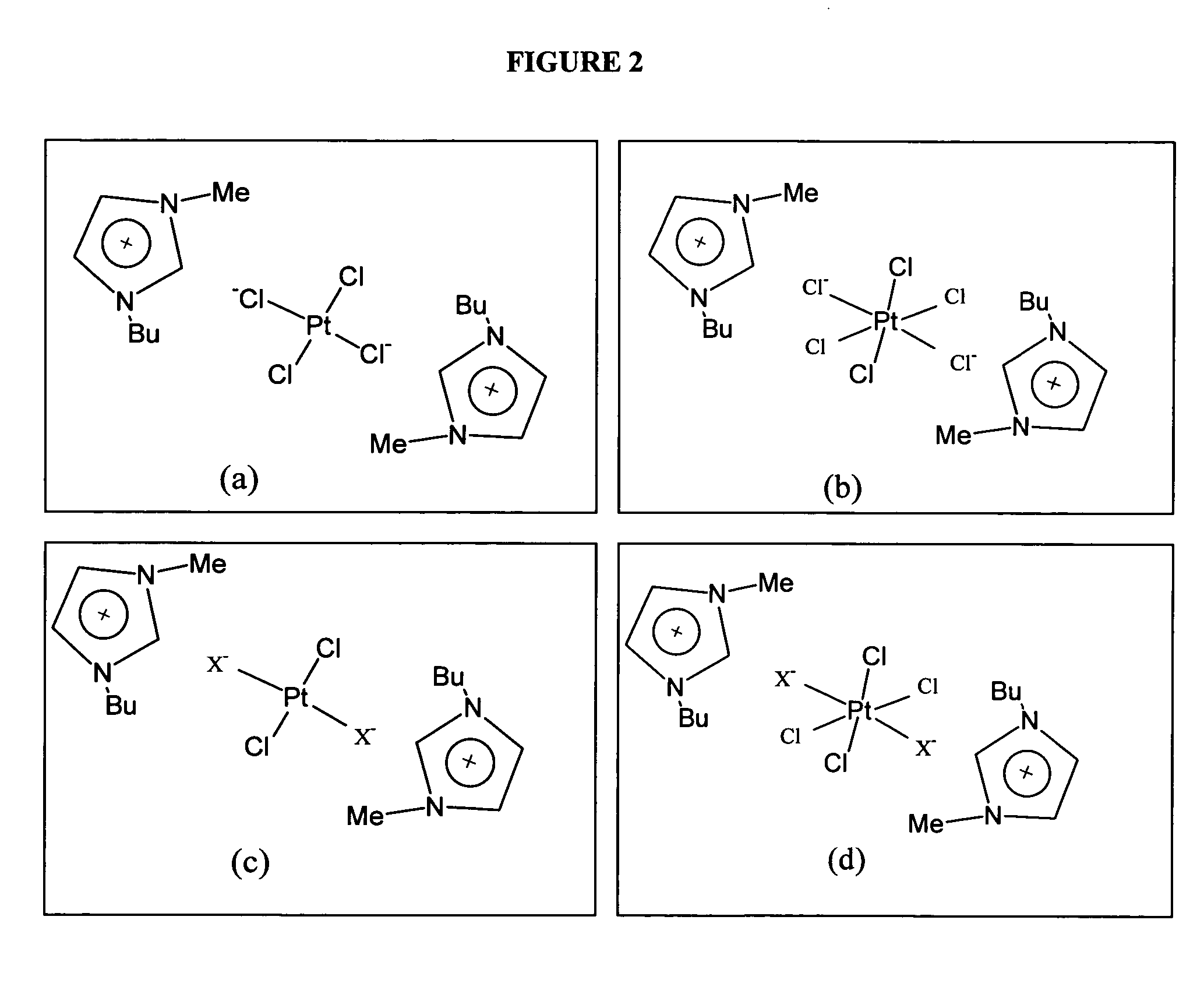Use of ionic liquids as coordination ligands for organometallic catalysts
a technology of organometallic catalysts and coordination ligands, which is applied in the preparation of sulfuric acid esters, oxygen compound purification/separation, and bulk chemical production. it can solve the problems of inability to commercialize such methods, inability to use such methods, and high cost of process, etc., to achieve the effect of facilitating homogeneous or heterogeneous catalytic reactions
- Summary
- Abstract
- Description
- Claims
- Application Information
AI Technical Summary
Benefits of technology
Problems solved by technology
Method used
Image
Examples
example 1
Compatibility of Oxidants and Reactants in Ionic Liquid Catalytic Systems
[0085] Tests were performed to determine the stability of oxidants and reactants for the conversion of methane to methanol, a process that requires H2SO4. Previous studies tested the compatibility for binary systems of ionic liquid —H2SO4 and the Periana catalyst, [bpym]PtCl2—H2SO4, at room temperature and at elevated temperatures (up to 220° C.). A binary system refers to a reaction system with two components. This example describes compatibility tests for two binary systems that include new varieties of ionic liquids as well as other types of Pt-based catalysts. Solubility tests of Pt-based catalysts in ionic liquids were also conducted.
[0086] The solubility and stability of four types of ionic liquids (ammonium-based, phosphonium-based, pyridinium-based, and imidazolium-based) in H2SO4 were analyzed as shown in Table 2. The cation and anion of each ionic liquid were separately evaluated for their stability...
example 2
Conversion of Methyl Bisulfate to Methanol
[0092] The majority of the ionic liquids that have been tested have been shown to be miscible with methanol (CH3OH) and are generally stable. Deuterated methanol (CD3OD) may be a good NMR solvent for ionic liquids. A small amount of methanol in concentrated sulfuric acid may exist in the form of methyl bisulfate (CH3HSO4), as evidenced by 1H NMR using D2SO4 as a solvent.
[0093] Extraction of methanol from concentrated sulfuric acid after the methane oxidation reaction may be one of the steps in the methane conversion process. The hydrolysis and neutralization of a standard methyl bisulfate solution in sulfuric acid was measured to model the process following oxidation of methane. About 55.7 μL CH3OH was dissolved in 10 mL 96% H2SO4. From this solution, 0.2 mL was removed and hydrolyzed into 5 mL deionized water to give a formal 100 ppm solution. Sodium hydroxide was added into the water solution to reach pH=7, which is a desirable condition...
example 3
Ambient Pressure Reactor Tests for Alkyl Oxidation
[0094] Studies using a low-pressure reactor were carried out to observe the kinetics of methane activation. Because the solubility of methane gas in sulfinuric acid solution at low pressures is somewhat low, the hydrogen / deuterium exchange rate in D2SO4 may be very small. An alternative method was used to model the effect of platinum-containing ionic liquid catalysts on a hydrocarbon moiety. Since 1-methyl-3-butylimidazolium chloride ([bmim] [Cl]) may dissolve all types of Pt-based catalysts (Table 4) and the butyl group may be oxidized in a ternary system (Table 5), it can be used instead of methane as a model compound for oxidation rate study. A systematic comparison between three catalytic systems, i.e., [bpym]PtCl2, K2PtCl4, and PtCl2, is presented in Table 6.
TABLE 6Oxidation rate study of H2SO4 / Catalyst / [bmim][Cl] ternarysystem at 200° C. [bmim] was used as a model compound foroxidation. Rates were determined based on 1H NMR ...
PUM
| Property | Measurement | Unit |
|---|---|---|
| Melting point | aaaaa | aaaaa |
| Melting point | aaaaa | aaaaa |
| Melting point | aaaaa | aaaaa |
Abstract
Description
Claims
Application Information
 Login to View More
Login to View More - R&D
- Intellectual Property
- Life Sciences
- Materials
- Tech Scout
- Unparalleled Data Quality
- Higher Quality Content
- 60% Fewer Hallucinations
Browse by: Latest US Patents, China's latest patents, Technical Efficacy Thesaurus, Application Domain, Technology Topic, Popular Technical Reports.
© 2025 PatSnap. All rights reserved.Legal|Privacy policy|Modern Slavery Act Transparency Statement|Sitemap|About US| Contact US: help@patsnap.com



